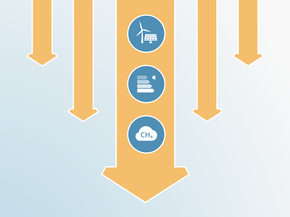Mitigation options
Overview
Although emissions in the aviation sector are more challenging to abate than in many other sectors, studies suggest it is possible for the sector to decarbonise by mid-century (Energy Transitions Commission, 2019) or in the second half of this century (Napp et al., 2019).
There is no one silver bullet to reduce aviation’s climate impact. To successfully reduce GHG emissions and other climate forcers, governments should impose a combination of abatement measures. Abatement measures can broadly be categorised into four categories: demand management, operational measures, improving energy efficiency, and the adoption of decarbonisation technologies.
Demand management
Demand management must play a crucial role in reducing aviation’s climate impact, particularly in the short term, as operational and technological measures have either limited abatement potential or are not yet available at scale (Sacchi et al., 2023). In general, governments and industry focus on technological and operational measures that have the potential to reduce emissions while accommodating growing demand for aviation. However, without explicit demand management measures that incentivise a modal shift away from aviation, there is a real risk that aviation emissions will not decrease quickly enough to be 1.5˚C compatible, even with the rapid expansion of SAFs and new technologies (Suomalainen, 2025).
In 2018, only 11% of the global population flew, and only 4% internationally (Gössling and Humpe, 2020). Just 1% of the global population was responsible for 50% of CO2 emissions from air travel in 2018. This suggests that emissions from aviation can decrease substantially if demand from frequent fliers reduces. However, it also implies that emissions from aviation will increase significantly if a larger share of the global population gets access to air travel.
Demand management includes encouraging a modal shift to high-speed trains or a reduction in travel, which can be incentivised, for example, through increased costs for airlines and passengers. The COVID-19 pandemic brought with it an increased reliance on video conferences to replace face-to-face meetings, and this, too, provides an alternative to the need for air travel. The IPCC’s Sixth Assessment Report showed that avoidance of long-haul flights and shifting short-haul flights to trains, amongst other socio-cultural factors, may reduce aviation emissions by 10–40% by 2050 (Creutzig et al., 2022).
Modal Shift
Governments can introduce policies to reduce the need for aviation, such as supporting a modal shift from short-haul flights to high-speed rail by making sustained and substantial financial investments in rail infrastructure (Energy Transitions Commission, 2019). Governments can implement regulations to reduce the number of airport time slots, during which an aircraft from a specific operator may land and take off from an airport.
It must be noted, however, that short-haul flights are responsible for a small share of total aviation emissions. Therefore, a modal shift should be seen as a complementary rather than a crucial mitigation measure (Graver et al., 2019).
Levies & taxes
Governments can reduce passenger demand for aviation by increasing the costs of flight tickets through taxes and fees, such as fuel and ticket taxes. Beyond reducing emissions from aviation, such taxes can generate significant revenues for governments. Governments can use tax revenues to support the buildout of less-emitting modes of transport, such as high-speed rail, or to address the highly unequal distribution of aviation emissions (Teusch and Ribansky, 2021).
Jet fuel taxes are more efficient in reducing emissions and raising revenues than ticket taxes (Blom et al., 2025). Although various countries tax jet fuel on domestic flights, there are few examples of a jet fuel tax for international flights (Larsson et al., 2019). The US has a federal tax rate of USD 0.01 per litre, but international air carriers may be exempted if agreed in bilateral Air Service Agreements (CE Delft, 2019). Although it is unlikely that countries will agree on a global tax on kerosene, states could enter into bilateral agreements to tax kerosene on flights between their airports (Larsson et al., 2019).
A number of countries, including France, Germany, South Africa and the United Kingdom, have implemented a ticket tax (Faber and Huigen, 2018). A study by (CE Delft, 2019) found that in most EU Member States, a 10% increase in ticket prices would result in a 9–11% reduction in demand and a similar reduction in the number of flights. In 2021, the European Commission proposed introducing a tax on kerosene on intra-EU commercial and private flights (European Commission, 2021). However, the proposal has yet to be adopted (see National policies section for more information).
Operational measures
Operational measures include improved air traffic management (ATM), such as optimising routing, air traffic flow management, and minimising flight distances. National governments should collaborate with airports and air navigation service providers to improve existing ATM infrastructure.
Research indicates that regional air traffic management, such as the Single European Sky framework, could save approximately 5% of CO2 by 2050 below business as usual (Energy Transitions Commission, 2019). The EU Council and Parliament agreed in March 2024 to revise the Single European Sky framework, which could unlock further emissions reductions (Soone, 2024). In addition to reducing carbon emissions, operational measures also have the potential of reducing the non-CO2 emissions from aviation. For instance, optimised routing can lead to a relatively large reduction in contrail formation and NOX emissions (Grewe et al., 2017).
Energy efficiency
Improved energy efficiency can be achieved by, for instance, improving the thermodynamic efficiency of new engines and the design of new aircrafts. Engines of the current fleet have an average motor thermodynamic efficiency of approximately 50%. Estimates suggest this could be improved to 65–70%, depending on the development of new materials, design, and component technologies (National Academies of Sciences Engineering and Medicine, 2016). Particularly promising are further advances in geared turbofan engines (IATA, 2024a). Further energy efficiency improvements can be achieved through novel, more aerodynamic designs like canard, truss-braced, and blended wing bodies and revolutionary changes in the positioning of fuel tanks, which would enable hydrogen-fuelled planes (Energy Transitions Commission, 2019).
National governments can support R&D focussing on improvements of airframe and engine efficiency (Energy Transitions Commission, 2019). Analysis from the International Council on Clean Transportation estimates that governments need to spend USD 0.8–1.4 trillion on supporting the development of emerging aviation technologies between 2020 and 2050 (Rutherford, 2020). Further, governments should set high efficiency standards for existing aircrafts, which would accelerate fleet turnover.
Decarbonisation technologies
Decarbonisation technologies include sustainable aviation fuels (SAF), hydrogen, and electric batteries.
Sustainable aviation fuels (SAF)
SAF are aviation fuels with a lower carbon content than standard jet fuel. Less than 1% of all jet fuel used today are SAF, but sectoral benchmarks for the aviation sector show that this share needs to increase to 10–15% by 2030 and 100% by 2050 (UNFCCC, 2021; Boehm et al., 2023; IEA, 2023). SAF are currently very expensive, which represents a challenge to wide-scale deployment (Scheelhaase et al., 2019; Searle et al., 2019). Government action, for instance in the form of SAF quotas and taxes on kerosene, are necessary to incentivise airlines to scale up SAF use.
Most SAF produced today are biofuels, which are made from, for example, waste cooking oil and forestry and agricultural residues. Synthetic power-to-liquid fuels, made from captured carbon, water, and (renewable) electricity, are expected to take up a significant share of jet fuels over the coming decades (Energy Transitions Commission, 2019; Searle et al., 2019). SAF have the advantage that the aviation sector could continue to use the existing infrastructure, vehicles, and engines, which allows a more gradual transition to alternative fuels (Scheelhaase et al., 2019).
SAF, in particular synthetic power-to-liquid fuels, are considered the decarbonisation technology with the largest emissions reduction potential for the aviation sector (Energy Transitions Commission, 2019; Searle et al., 2019). An assessment of 12 aviation decarbonisation roadmaps found that the production of SAF could require 9% of global renewable energy and 30% of the world’s sustainable biomass by 2050 (Becken et al., 2023).
These roadmaps show that SAF can reduce CO2 emissions in the aviation sector by 70% by mid-century, compared to scenarios with no or limited mitigation action. However, this may be an optimistic estimate, as the roadmaps do not account for the decadal time lags between the point at which biofuels from forest biomass are burned and the point at which newly planted trees start to sequester carbon dioxide.
While the production of SAF needs to rapidly increase to decarbonise the aviation industry, there will be economic and social limitations to the amount of SAF that can be produced. Producing SAF requires significant amounts of renewable electricity, which other sectors also need to reduce their emissions (Becken et al., 2023). This means that scaling SAF production presents a huge opportunity cost for decarbonising other sectors, including the power sector.
Scaling up SAF also requires more land dedicated to renewable energy installations and possibly the production of bioenergy crops (Becken et al., 2023). This land can then no longer be used to grow food crops or store carbon, which makes it more difficult to neutralise economy-wide residual emissions and to bring global emissions to net zero. In addition, SAF does not necessarily reduce the non-CO2 climate effect of aviation.
For these reasons, SAF are not the silver bullet to decarbonising the aviation industry. Rather scaling SAF should go hand-in-hand with demand management and other abatement measures.
Hydrogen
Hydrogen, in particular liquid green hydrogen, is receiving increasing interest as an alternative to SAF (Mukhopadhaya and Rutherford, 2022). Liquid green hydrogen would have zero CO2 and non-CO2 emissions, but hydrogen combustion in fuel cells would produce water vapour and therefore result in contrail cirrus, which has a radiative forcing effect.
However, neither liquid hydrogen nor hydrogen fuel cells are mature technologies. The rollout of hydrogen-power aircraft and necessary infrastructure is not expected to happen before 2035 (Grimme and Braun, 2022). In an ambitious scenario, hydrogen aircraft could reduce emissions from aviation by about 15% by 2050. Since hydrogen-power aircraft are heavier and less efficient than aircraft flying on fossil fuels or SA (Mukhopadhaya and Rutherford, 2022) F, their uptake will likely be limited to short- and medium-haul flights where they may also compete with high-speed rail.
Like SAF, liquid hydrogen and fuel cells are still substantially more expensive than jet kerosene, which presents a barrier (Hoelzen et al., 2022). The production of hydrogen at scale also needs massive amounts of renewable energy (Grimme and Braun, 2022), which is currently not available. Scaling renewable energy production for the aviation industry presents an opportunity cost to decarbonising other economic sectors.
Electric batteries
Electric batteries charged with renewable energy have no in-flight emissions and non-CO2 effects (Hoelzen et al., 2022). Battery-electric aircraft are also more energy-efficient than aircrafts fuelled by SAF, the production of which incurs large energy losses.
However, electric batteries are not expected to be feasible at scale by mid-century, except for short-haul flights where they may compete with high-speed rail (Hall et al., 2018; Mukhopadhaya and Graver, 2022). The ICCT estimates that electric aircraft can contribute to an annual reduction of 3.7MtCO2 by 2050, if electric aircraft are used on all possible routes (Mukhopadhaya and Graver, 2022). This represents 0.2% of expected emissions from the aviation industry (domestic and international) by mid-century.
Economic barriers and policy action
Airlines had a small profit margin prior to the COVID-19 pandemic and their economic situation has worsened since. This likely slows down the shift to a more sustainable aviation sector (Peeters and Melkert, 2021). While governments around the world spent billions of dollars on airline bailouts, they generally did not attach binding environmental conditions (Bogaisky, 2020; Climate Action Tracker, 2020; T&E et al., 2021).
To realise the mitigation potential from alternative fuels and electric batteries, it is crucial that national governments play an active role and, among others, set sustainable fuel quotas for aviation (Larsson et al., 2019), as well as establish clear sustainability criteria that such fuels should meet. Governments could also provide financial support, such as grants and loan guarantees, to lower financial risks for biofuel refinery project investments and use public expenditure to support R&D of alternative fuels (Energy Transitions Commission, 2019; Feuvre, 2019).
Carbon dioxide removals
Bringing the aviation sector onto a 1.5°C-compatible trajectory requires deep emission reductions, while durable carbon dioxide removals (CDR) will be necessary to neutralise residual CO2 emissions in the sector and reach net zero by mid-century (NewClimate Institute, 2025). Some argue that the aviation industry should use Direct Air Carbon Capture and Storage (DACCS) where this is cheaper than developing synthetic SAF, which are based on captured CO2 (Höglund and Sivaraju, 2024). However, DACCS, and other durable CDR technologies, cannot serve as a replacement for deep emissions reductions for various reasons:
- Durable CDR technologies face a range of risks and constraints. DACCS, for instance, has a high clean energy demand (Lux et al., 2023). This clean energy is currently not available - and the airline industry would be competing with other sectors to decarbonise. DACCS also has huge water requirements, which conflicts with other environmental and social objectives (NewClimate Institute, 2025).
- There is scientific uncertainty about carbon cycle responses on emissions and removals: one tonne of CO2 removed from the atmosphere does not necessarily offset the climate impact of one tonne of CO2 emitted (Zickfeld et al., 2021).
- Capturing and storing CO2 requires continued monitoring, reporting and verification, alongside high liability guarantees (NewClimate Institute, 2024).
- CDR does not address the non-CO2 radiative forcing impacts of aviation, which may account for two thirds of aviation’s total climate impact (Lee et al., 2021).
- Durable CDR is not yet proven, let alone operational at scale. If the aviation sector were to count on future CDR capacity—which may never materialise—at the cost of implementing readily-available emissions reduction measures, the sector will very likely overshoot its remaining carbon budget under fair share pathways.
For these reasons, deep emissions reductions through demand-reduction measures and decarbonisation technologies should be the main priority for the aviation sector (Sacchi et al., 2023). Durable CDR should only be used to neutralise residual CO2 emissions that remain after these decarbonisation efforts.
Further analysis
Latest publications
Stay informed
Subscribe to our newsletter





